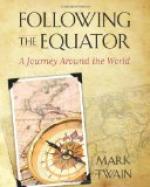But No. 3 is my favorite. Whenever I read it I seem to enjoy all that the patient enjoyed—whatever it was:
3. “Once at King George’s Sound a native presented himself to me with one leg only, and requested me to supply him with a wooden leg. He had traveled in this maimed state about ninety-six miles, for this purpose. I examined the limb, which had been severed just below the knee, and found that it had been charred by fire, while about two inches of the partially calcined bone protruded through the flesh. I at once removed this with the saw; and having made as presentable a stump of it as I could, covered the amputated end of the bone with a surrounding of muscle, and kept the patient a few days under my care to allow the wound to heal. On inquiring, the native told me that in a fight with other black-fellows a spear had struck his leg and penetrated the bone below the knee. Finding it was serious, he had recourse to the following crude and barbarous operation, which it appears is not uncommon among these people in their native state. He made a fire, and dug a hole in the earth only sufficiently large to admit his leg, and deep enough to allow the wounded part to be on a level with the surface of the ground. He then surrounded the limb with the live coals or charcoal, which was replenished until the leg was literally burnt off. The cauterization thus applied completely checked the hemorrhage, and he was able in a day or two to hobble down to the Sound, with the aid of a long stout stick, although he was more than a week on the road.”
But he was a fastidious native. He soon discarded the wooden leg made for him by the doctor, because “it had no feeling in it.” It must have had as much as the one he burnt off, I should think.
So much for the Aboriginals. It is difficult for me to let them alone. They are marvelously interesting creatures. For a quarter of a century, now, the several colonial governments have housed their remnants in comfortable stations, and fed them well and taken good care of them in every way. If I had found this out while I was in Australia I could have seen some of those people—but I didn’t. I would walk thirty miles to see a stuffed one.




